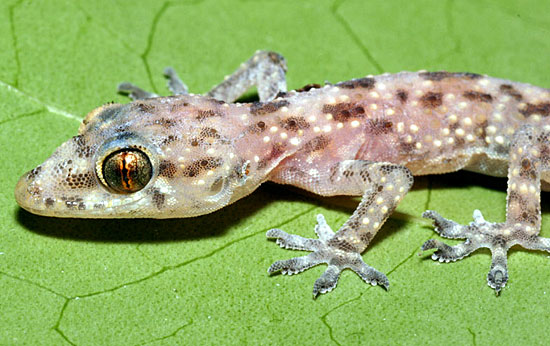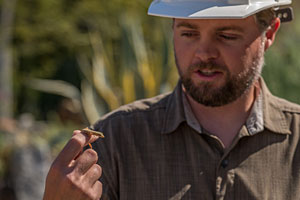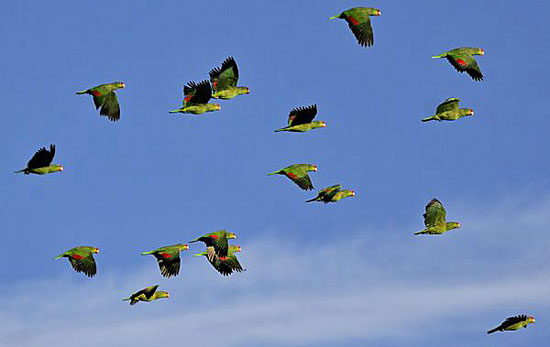L.A.’s biggest science project ever
June 13, 2013

Natural History Museum “citizen science” yielded the first L.A. sighting of this gecko species. Photo/Gary Nafis
When the Natural History Museum of Los Angeles County launched its recent renovation, one of the goals was to make room for more science. Turns out it also made room for more scientists—of the backyard amateur variety, no lab coat required.
With the addition of the new Nature Lab and Nature Gardens as part of its centennial celebration, the museum’s growing involvement in so-called “citizen science” projects has gained new prominence, enlisting Southern Californians by the thousands in projects to catalogue the region’s biodiversity.
From insect counts to inventories of freeway roadkill, the museum has more than a dozen initiatives that are either ongoing or in the works now in which the public is playing a key role in the study of wildlife in Los Angeles County.
“It’s like crowdsourcing, and it can be an amazing resource,” says Lila Higgins, manager of citizen science and live animals at the museum.
Also known as participatory science, citizen science has become increasingly common as technology has made it easier for scientists, professional and amateur, to share observations and collaborate.
“In some ways, it isn’t new,” says Greg Pauly, curator of herpetology at the Natural History Museum, noting that volunteers at the NHM’s Page Museum have been helping process fossils for many years. “But with the Internet and smart phones and other digital devices, anyone can, say, photograph an organism and send it over the net to be included in scientific research. And people of all ages can help that way.”
Worldwide projects, such as the extraterrestrial life site SETI@Home, and the ornithology database eBird, have been reaching out to the public for more than a decade, and the Natural History Museum has been among the local pioneers of the concept. As far back as 1994, for instance, museum ornithologists enlisted the public in a study of feral parrots in Southern California.
The California Parrot Project, which is still ongoing, asked birdwatchers to let the study’s organizers know about local parrot sightings, and eventually yielded one of the first reliable counts of the numbers—upwards of a dozen species—of parrots breeding in the wild here, says Kimball L. Garrett, ornithology collections manager at the museum.
“It was extremely primitive—we’d mail out newsletters,” says Garrett. “But all this research from the mid-1990s gave us a baseline to figure out whether these populations are expanding or contracting now.”
Of the museum’s current batch of citizen science projects, the oldest is the 11-year-old Spider Survey, which asks the public to collect spiders in their homes and gardens, take down some data and bring or send what they find to the museum, Higgins says.
“At the time, it was the cutting-edge thing,” she remembers. “We launched it in 2002 at the museum’s Bug Fair, and the first week, a thousand spiders came in.”
Since then, some 6,000 spiders have been sent into the museum from throughout Los Angeles County; among the project’s findings was the first sighting of a brown widow spider in L.A.
“We’re a port city with people and goods coming and going on a daily basis, and with them, creatures sometimes hitch a ride,” Higgins explains.
Other citizen science projects have yielded even more exciting data. In 2010, Will and Reese Bernstein, a father and son from Porter Ranch, submitted a photo of a tiny reptile they’d seen at a backyard dinner party to the museum’s Lost Lizards of Los Angeles project. The critter turned out to be the first documented discovery of a Mediterranean House Gecko in L.A.
Although the non-native gecko (also known as Hemidactylus turcicus) has been spotted in the southeast United States, the L.A. sighting was so significant that the Herpetological Review plans to publish the finding this fall, says Pauly: “So Reese Bernstein, who is 12 years old now, will already have published a paper in a scientific journal.”
In April, the Lost Lizards project turned up yet another out-of-state reptile, an Indo-Pacific Gecko that was found in a backyard in Torrance. The project has been so successful, in fact, that it’s being expanded to include amphibians.

Greg Pauly’s Lost Lizards of Los Angeles project worked so well that it’s expanding. Photo/SoCal Wild
“Maybe you see a turtle at the park, or an alligator lizard in your yard, or maybe a salamander in the Santa Monica Mountains,” says Pauly. “You submit a photograph of it to our project, and that data will be available to scientists for generations to come.”
Coming up will be the citizen science component of Bioscan, a 3-year look at, among other things, the diversity of Los Angeles insects. Project Coordinator Dean Pentcheff is looking for a homeowners willing to host bug traps in their backyards and volunteers willing to sift through the take, sorting beetles from butterflies. A special side project in August will count bugs drawn to porchlights.
“We’re about three months in,” says Pentcheff, “and already we’ve found new species unknown to science.”
Pauly, the herpetologist, says such projects are especially important in places like Los Angeles County because the interface between the wilderness and the expanding urban landscape is on the cutting-edge of science these days.
“When you ask people here where they go to see nature, they say things like, ‘Sequoia’ or ‘Anza Borrego.’ But we’re surrounded by incredible diversity, and you don’t even have to leave L.A.”
Posted 6/13/13















 405 bridge work causes a stink
405 bridge work causes a stink